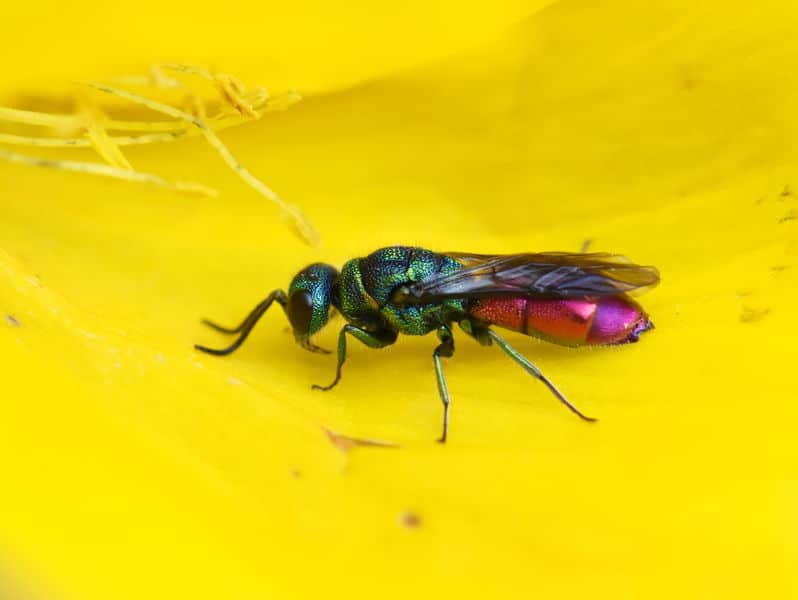The cuckoo wasp, Chrysididae, also known as the emerald wasp is found in hot arid regions around the world.
How did cuckoo wasps get their name?
They lay their eggs in other insects’ nests. Just like their namesake the cuckoo bird, they lay their eggs in other species’ nests. The wasp larva when hatched will consume the host larva or egg and then consume the food intended for the host larva. This saves the cuckoo wasp from having to do its own foraging and nest preparation for its offspring. The species that are selected as hosts vary but include other wasp species and bees.
How do cuckoo wasps find victims?
The cuckoo wasp will spy on potential hosts in order to find nests that they can penetrate and lay their eggs in. They will follow other wasp species and observe them building nests and delivering food. Then they will wait for the wasp to leave and at an opportune time penetrate the host nest and deposit their own egg within.
How do cuckoo wasps enter host nests undetected?
They can chemically camouflage themselves. When entering a host nest some cuckoo wasps can cover their infiltration by releasing a chemical that mimics the scent of their host species. Certain cuckoo wasps that have specialized in targeting specific host species have evolved this ability.
What do cuckoo wasps look like?
They have brilliant metallic colors. Cuckoo wasps are very distinctive with radiant metallic colors. The colors may have evolved as a form of camouflage. The reflection of light on the wasp gives it a metallic tinge.

Can cuckoo wasps sting?
Unlike most wasps, they lack the ability to sting. In place of the ability to sting they have a long telescopic ovipositor that can penetrate host nests and deposit an egg. Other wasps species such as the gall wasp use their ovipositor to deposit eggs inside plants. The cuckoo wasps ovipositor can drill into the nests of potential hosts including the mud nests of digger wasps. They cover their tracks by repairing any damage to the nest. This way their deposited egg can go undetected.
How do cuckoo wasps defend themselves?
They can fold their bodies into a protective ball. Unlike other wasp species cuckoo wasps have the ability to roll themselves into a protective ball. This can be compared to the tactics deployed by species such as hedgehogs. They may have evolved this protective ability as they are unable to sting and also by infiltrating other wasp nests they are vulnerable to attack.
In addition to their ability to roll into a protective ball, they also have thick armor-like exoskeletons capable of withstanding attacks. In this way, they are able to protect any vulnerable areas. Predators find it difficult to crush, bite, or sting this protective layer. If caught in a host’s nest they can roll into a ball and ride out an attack.
How old are cuckoo wasps?
They have gone unchanged for millions of years. Fossils preserved in amber discovered in Myanmar in 2020 show cuckoo wasps dated to 99 million years ago are virtually identical to those found today. Remarkably, the green color of the insects was preserved matching the green seen on cuckoo wasps now.
